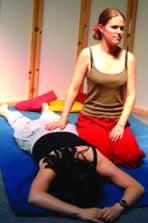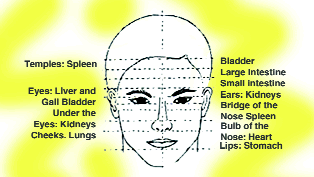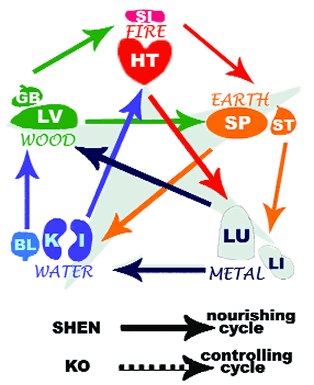Positive Health Online
Your Country

Shiatsu - Ancient Technique for the 21st Century
listed in shiatsu, originally published in issue 95 - January 2004
Then and Now
When mother first touched child to 'make it better' she invented what we in the 21st century know as Shiatsu. An Emperor of ancient China created a technique. A psychologist in modern Japan organized a protocol. And the West institutionalized it.

The First Touch of the Mother-Hand
Huang-Ti (2697-2598 BCE), the Yellow Emperor, codified the theory behind the therapy. Treatment, from acupuncture to herbs, should vary according to lifestyle. For those "able to obtain a varied diet without great exertion" massage was recommended for spiritual, energetic and physical health by maintaining harmony among the Five Elements: Fire, Earth, Metal, Water and Wood. Three millennia later, Tang Dynasty (618-906 CE) research on condemned prisoners confirmed flows of energy through invisible channels.
Modern 'Traditional' Chinese Medicine (TCM) evolved in the 1950s, synthesizing traditional approaches from different regions but purged of their spiritual aspects. Now dialectically materialist and politically correct, TCM could be practised alongside western medicine in the hospitals of new China.

Looking Diagnosis – Organs in Face
In 1977 the Japanese psychologist Shizuto Masunaga, with his student Wataru Ohashi, developed a set of protocols integrating psychotherapeutic thought, meridian connection and physical pressure. They described how to induce the phenomenon that occurs between meridian points under pressure and published it as Zen Shiatsu – how to harmonize Yin and Yang for better health. But in postwar Japan the only form of Shiatsu officially licensed was based on the western Nervous System.
Shiatsu went West and found a home among the eclectic materialists of the New Age. Yin, Yang and Zen, involving touch and supported by a rational theory, alleviated symptoms of many chronic conditions resistant to orthodox medicine and could reduce the need for medication. Western Schools described shiatsu as "a Japanese form of physiotherapy". What began as intuitive loving-touch practised by barefoot blind healers wearing red head-bands became the subject of theses and dissertations.
The gap between rational/physical and traditional/spiritual began to close with the publication in 1988 of Hara Diagnosis – Reflections on the Sea.[1] Matsumoto and Birch wrote of the flicker of life, the moving Qi between the kidneys. In 1989 Dr Motoyama brought his Qi machine to London and demonstrated to dignitaries representing interests from scientific to esoteric the measurability of energy flow through the connective tissues at 1.5 volts – hey, presto! Energy is real, meridians exist!
Shiatsu-related techniques multiplied in the 80s and 90s with the development of Ohashiatsu – Touch for Love, Shizuko Yamamoto's Barefoot Shiatsu, macrobiotic shiatsu, Mantak Chia's Chi Nei Tsang (internal organ energy massage), Five-Element Shiatsu (unknowingly based on ancient taoist alchemical practices still considered by some as black magical superstition), energy-shiatsu (kiatsu), water-shiatsu (watsu) and even tantric (tanatsu). One style of shiatsu not recognized by any of British groups was the one licensed by the Japanese Ministry of Health.
Potential for harmony between the three main approaches, Zen, Five-Elements and TCM was illuminated in 1995 by Carola Beresford Cooke in Shiatsu Theory & Practice.[2] Then, in 1996, Simon Fall sparked the realization that it was not all just finger-push with As Snowflakes Fall, Shiatsu as Spiritual Practice.[3] Two years later Nourishing Destiny – the Inner Tradition of Chinese Medicine[4] by an American acupuncturist, Lonny Jarrett, restored the spiritual foundation excised by Mao's dialectical materialists. Shiatsu in the West was ready to enter the new millennium.
British institutionalization continued apace as Societies and Associations with Rules and Regulations proliferated, seeking authenticity with examinations, assessments, accreditation, validation and moderation, playing politics in the race for acceptance by the 'establishment'. In 2001 the General Shiatsu Council was formed to play the game of Europe and, hopefully, preserve the English freedom to practise (since the repeal of the witchcraft legislation in 1947) complementary therapies without restriction.
Beyond the politics, the 21st century Shiatsu Practitioner draws from the source, using Heart Connection to practise a proven theory based on the ebb and flow of the force known as Qi, bioelectromagnetic energy or energy intelligence.

Interplay of Organs and Elements
How Does Shiatsu Work?
The difference between Shiatsu and other forms of touch-therapy, such as massage, is that Shiatsu is a form of Taoist Healing, sharing theory with acupressure and acupuncture but differing in approach, aspects of diagnosis, treatment, and the personal self-development of practitioners.
The Shiatsu Approach is holistic: a hands-on therapy to harmonize the flow of energy throughout the entire being – mind, body and spirit – to seek the underlying cause of conditions as well as relieving symptoms; to open the Receiver's awareness to the environment hosting the condition; to enable the Receiver to participate in their own healing process, while understanding Nature as the true healer and Shiatsu an intermediary.
Shiatsu Diagnosis uses the Four Forms, sharing with acupuncture the techniques of Looking and Asking, to discover the environment in which the conditions develop, and using Sensing and Touching to ascertain what is manifesting in the moment. Sensing involves scanning the energy-field to feel the different energy-levels. Touching Diagnosis is initially based on the Hara, the area between ribs and hips, a confluence of internal meridians.
Sensing and Touching the diagnostic areas of each organ-meridian network shows degrees of imbalance, Kyo and Jitsu.
Kyo – the world of emptiness, neediness, lack: often the underlying cause, a more Yin state.
Jitsu – more excessive, more obvious, often the symptom and more Yang.
Diagnosis is treatment, treatment is diagnosis. The practitioner continues Looking and Asking to see and hear how the Receiver is responding, especially to pressure, and adapts to changes felt in meridians and Tsubos (acu-points).
Shiatsu Treatment works on three levels:
- Physical: shi atsu means finger-push. When the Giver's finger or thumb makes contact with the skin of the Receiver, even through the light clothing recommended for receiving a treatment, heat is generated, melting the gel around cells in the vicinity. As the gel becomes a solution, suspended toxins are released into the lymphatic system to be eliminated through the cardiovascular and respiratory systems;
Health warning: too much push can be very uncomfortable for the receiver and too much detoxification can strain elimination systems and induce a 'healing crisis'. One difference between an amateur and a shiatsu professional is that the professional knows when to stop!
- Energetic: the solution better allows conduction of the Qi's healing message through the connective tissues and organ-meridian networks regulating the body-mind systems.
- Mental/Spiritual: Connection with Spirit and conscious use of Intuition are supported by Intention: where the Mind goes, the Qi follows, and where the Qi flows, the blood follows.
The Shiatsu Practitioner: Skill, knowledge and intuition are consciously developed, like the training of mind and muscle in conventional education. Vulnerability to energy-depletion, contamination and karmic debt is countered with self-cultivation – not just encouraged, it is a requirement for qualification. Whether a Receiver suffers from a terminal condition, emotional problem or simply needs stress relief, the Giver guards against the risk of karmic interference by acknowledging, from a deep well of loving-kindness, that each being is responsible for itself.
"Let the right outcome happen."
Qi connects mind and body: to help harmonize Qi flow in others, the practitioner looks after the flow in self, with attention to diet, way of living and meditational exercises, such as Qi Gong and Tai Chi.
Conditions Shiatsu is Effective For
By stimulating or dispersing Qi through the organ-meridian networks, Shiatsu is effective for all the major anatomical systems. Symptoms can be relieved of stress-induced and other common ailments such as head-, neck- or back-ache, joint pain, arthritis, colds, constipation, insomnia, menstrual problems and other chronic conditions. Clients often use medical jargon which the practitioner relates to the Shiatsu model of stimulating or dispersing Qi. Assessing the interplay of elements in the Receiver yields recommenda-tions for self-healing and to prevent recurrence.
Symptoms are outward signs of inward dis-harmony. For example, a cold, with a red and runny nose, might show as Lung jitsu in the Hara diagnosis. The therapist seeks the deficiency which allowed the cold to enter, take hold, grow and flourish! This might show as kyo of the Triple Heater, connected with the immune system. The treatment would seek to address both, tonifying kyo and dispersing jitsu.
Contra-Indications and Controversy
Cancer – There are two opposing views on shiatsu treatment for cancer with medical evidence for neither. One is that enhancing energy-flow facilitates the spread of cancerous cells. The other claims that, by fortifying the immune system, shiatsu helps counter the side-effects of conventional treatment. In practical terms, when a cancer patient seeks out a shiatsu practitioner they have usually sought elsewhere without satisfaction.
Children – Shiatsu being 'Complementary' and not Primary' health-care, it is both contra-indicated and illegal to treat a sick child instead of medical treatment. A signed disclaimer or authority from the parent does not legalize it!
Infectious/contagious diseases – treatment is contra-indicated.
Pregnancy – in the first trimester pressure is contra-indicated on certain Tsubos with elimination properties.
Inflammation – rotations, stretches and manipulations are contra-indicated.
Positions, Moves and Techniques
Although Shiatsu styles range from the mechanical to the mystical, any sensitive therapist will explore no further than the edge of pain, using it as a diagnostic tool, and is careful to detoxify no more than their Receiver can eliminate. Treatments last an hour or less, avoiding depletion of Giver and Receiver or both.
Positions
Shiatsu is usually given at floor level. The practitioner works from a grounded posture in a variety of positions:
- Prone: the Back is a harder, more Yang area able to take stronger pressure; presents Diagnostic Areas indicating longer-term conditions;
- Supine: softer, more Yin, less pressure but more movement; presents Diagnostic Areas of the Hara;
- Side: enables treatment of both Front and Back at the same time and full movement of the arm. Particularly suitable for people who find it difficult to lie prone, as in pregnancy;
- Seated: full movement and limited treatment of upper body; requires special attention to support; appropriate for Receivers unable to lie down; confined spaces, social situations.
Techniques
Techniques include using:
- Thumb or Finger for focussed pressure in the Tsubos (acu-points);
- Palm for sensing Qi, pressure and holding;
- Edge or Heel of palm for meridians;
- Hand for giving support and massaging organs;
- Forearm for meridian lines;
- Elbow for deep-focussed pressure;
- Thigh for support in Seated;
- Knee for deep-focussed pressure;
- Feet for soles;
- Manipulation for tension;
- Rotation to check mobility;
- Stretches for dispersal.
Moves
First Touch: spiritual, energetic and physical introduction.
Making Connection: connecting the flow of Qi until it feels there is only one place of contact.
Natural Leaning Palm Pressure: giver directs her own Hara to Receiver.
Ampuku deep in Hara: after Hara diagnosis, releasing tension with ampuku.
Rotation to test mobility: giver supports and moves Receiver's limb.
Meridian Stretch: giver moves to disperse Qi in jitsu meridians.
Support for a Head Rotation: receiver is supported by the Giver's body, almost as if in a chair, while the Giver builds trust gently holding her head.
Seeking a Tsubo: working a point in the shoulders. Seated position shows the importance of support.
The First Touch is the Last: giver takes time to disconnect gently, as if saying goodbye to a friend.
Case Study – Insomnia
Mrs A, aged 47, had tried different therapies, including western medicine. She arrived with her husband. In reply to my "Why have you come for Shiatsu?" he said, "She can't relax".
She agreed, "I can't relax."
Throughout the asking-diagnosis he answered and she agreed.
She was stiff and nervous. Starting on her side, I found her tension came not so much from stiff joints as a holding-together of herself.
On her back, she flopped, and soon fell asleep. At the end, she was amazed. "But I can never sleep. I can't relax enough."
I said, "Your body has learnt something, even if you didn't think it could".
Treatment had taken effect below the conscious level, where her energy-field had opened to the possibility of relaxation.
Next time her husband waited outside, and on the third visit she came alone, looking relaxed. She had become able to sleep without tablets, even without reading and without a light on.
Once asleep she slept through the night.
Case Study – Constipation
Reason for wanting Shiatsu: ten years constipation, recent headaches. Miss B had tried homeopathy, colonic irrigation, aloe vera and reflexology.
Looking Diagnosis: facial hue pale, breathing shallow.
Asking Diagnosis: busy lifestyle, difficulty letting things go. Diet excluded wheat, dairy, and caffeine. Maximum three glasses of wine a day. Regular yoga and walking. Menstruation regular.
Sensing and Touching: the interplay of elements showed a pattern of swing between overcontrolling and neediness in the Ko cycle in the Back (long-term) Diagnosis.
Hara Diagnosis on first treatment: Lung/Large Intestine, deficient. Bladder, excess.
Treatment plan: tonify Metal to improve respiration and excretion. Tonify Earth element to support Metal in the Shen (Nourishing) Cycle and regulate Water in the Ko (Controlling) Cycle.
Treatment: first treatment tonified Lung, dispersed Bladder, tonified Large Intestine 4, Ampuku around Stomach
25. Post-treatment hara diagnoses showed the same pattern but less extreme.
Self-help recommendations: Abdominal massage, breathing exercises.
Response: Interesting patterns emerged; when Miss B reported improvement, Hara Diagnosis showed an elemental pattern of neediness. With no improvement or a relapse, Hara showed over-controlling.
Miss B identified stress from life-issues, a tendency to over-control before treatment and swings between holding and releasing emotion.
Conclusion: Miss B was amazed by the improvement over the course of seven fortnightly treatments, felt more in control of her 'healing' and emotional swings and more connected with her hara. She intended to continue with self-help and return for 'maintenance treatments'.
Learning Shiatsu
Helping others is a way of enriching life, of satisfying our own energy-needs. You don't have to be a saint – for example, Mother Teresa, Mahatma Gandhi and others who wrote of the satisfaction of giving service were simply helping themselves to fulfillment in their own way. Points to consider when choosing a school or teacher might include location, timings and costs of training; pre- and post-graduate ongoing support, back up, referrals; teacher qualifications – mainstream educational as well as specialist shiatsu? Trained in Japan? For more information call 0700 078 1195 or visit www.learn-shiatsu.co.uk
References
1. Matsumoto & Birch. Hara Diagnosis – Reflections on the Sea. Paradigm. Brooklin. 1988.
2. Beresford-Cooke C. Shiatsu Theory & Practice. Churchill Livingstone. 1995
3. Fall S. As Snowflakes Fall, Shiatsu as Spiritual Practice. Hazelwood Press. Newton Abbott. 1996.
4. Jarrett L. Nourishing Destiny – the Inner Tradition of Chinese Medicine. Spirit Path Press. Stockbridge. 1998
Resources
Chia M & M. Chi Nei Tsang. Healing Tao Books. Huntingdon. 1990.
Masunaga & Ohashi. Zen Shiatsu. Japan Publications. Tokyo. 1977.
Ohashi W. Reading the Body – Ohashi's book of oriental diagnosis. Arkana. London. 1991.
Ong H-T. Chinese Black Magic – an Expose. Eastern Dragon Press. Kuala Lumpur. 1995.
Serizawa K. Tsubo – Vital Points for Oriental Therapy. Japan Publications. Tokyo. 1998.
Veitch I tr. The Yellow Emperor's Classic of Internal Medicine (Nei Jing). University of California Press. Berkeley. 1966.
Comments:
-
No Article Comments available